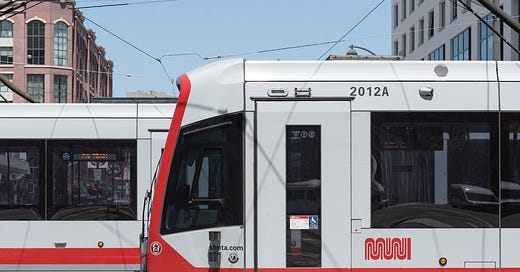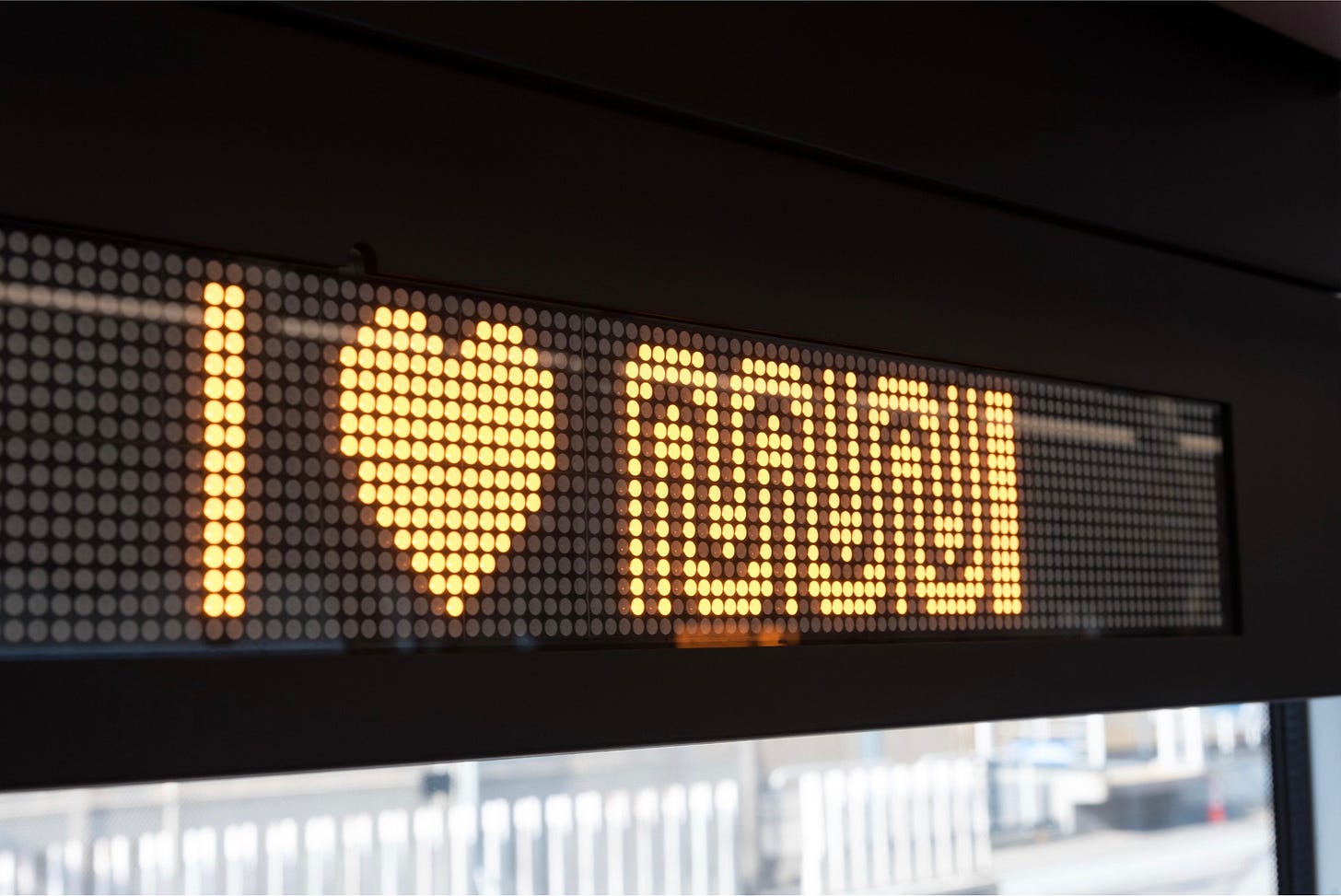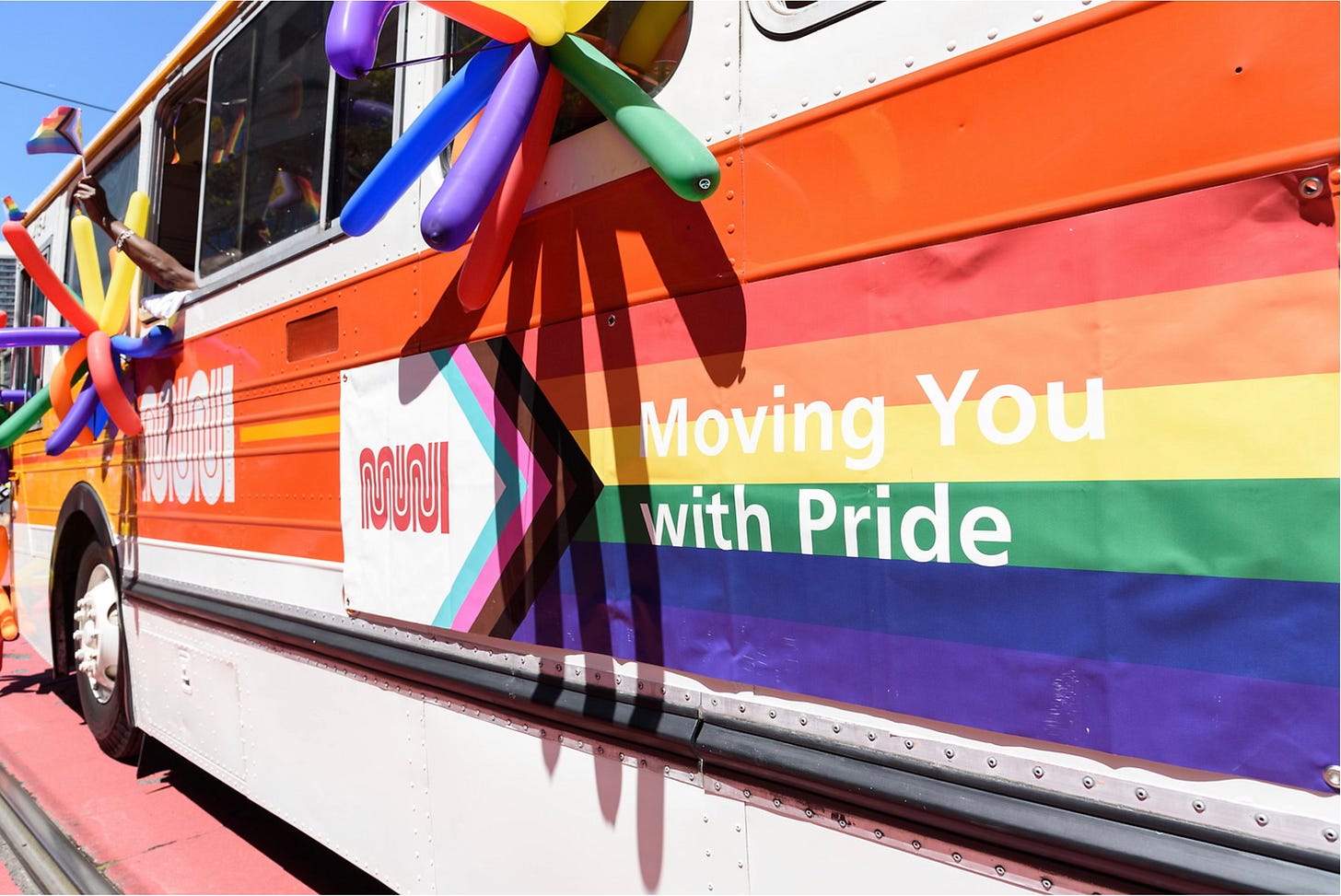San Franciscans: Show Your Love for Muni.
The Crisis of Transit is an Opportunity for Civic Renewal.
The Crisis
The SFMTA, in charge of San Francisco’s transit (Muni) and streets, faces a $50 million budget deficit this July, projected to grow to $320 million by June 2026. Senators Wiener and Arreguín's SB 63 would put a regional sales tax measure before voters in November 2026 to fund operations for Muni and other transit systems. Even if passed, related funding would come too late for at least the upcoming fiscal year. Governor Newsom’s “May Revise” state budget proposal doesn’t even include the proposed measure and instead slashes existing transit funding.
Muni recovered 75% of pre-COVID ridership last year, while car use is nearly back at pre-pandemic levels. The Bay Area Return to Office report shows a higher share of on-site work, but a prevalence of employees driving rather than riding. Employers cite scheduling and frequency, along with security and safety concerns, as the primary inhibitors to using transit. Yet, transit service levels track ridership and are therefore below pre-pandemic levels.
Lack of money, slow ridership recovery, reducing service, ceding of modal share to cars: This was not the plan.
Fifty-three years ago, San Francisco implemented a transit-first policy, and the city’s 2021 Climate Action Plan sets a target for 80% of all trips to be low-carbon (transit, walking, biking) by 2030. (Meanwhile, California’s plan to transition to zero-emission cars and trucks is under federal attack.)
Pecunia sine qua non, the agency is finalizing a plan to raise revenue and cut costs, relying mainly on the above tax increases and further service reductions to meet its goals.
However, tax hikes require citizen approval, and shrinking services is an unproven way to nurture a system back to health.
On the current trajectory, a death spiral of reduced utility for riders, leading to reduced utilization by riders, is more likely.
City leaders should not relinquish the 2030 transit goal. Instead, they should not let this crisis go to waste.
The Opportunity
The SFMTA’s numerous efforts to enhance the ridership experience have led to record passenger satisfaction, gauging the sentiment of existing riders.
However, improving the experience while reducing service will not achieve the 2030 goal.
For that, many more people will have to ride many times more than ever in history.
For that, San Franciscans need to buy into the 2030 transit vision, directly, quickly, literally.
Three favorable preconditions:
Few public services can create as much universal impact or achieve as rapid, visible, and tangible results as transit. Muni is already iconic and beloved.
More San Francisco employees are returning to the office, at least on some days of the week. If there was ever a time to influence modal choice, it is now.
Mayor Lurie, Chief of Infrastructure, Climate and Mobility John-Baptiste, and Transportation Director Kirschbaum are three new, ambitious, and capable city leaders well-positioned to carry the torch for transit.
With everything from civil liberties to climate action under attack, citizens seek common causes, engagement, unifying leadership, and better results more than ever. The time is ripe for civic renewal.
To realize that potential for Muni, leadership must do three things:
Stop framing mass transit as a social service.
Framing transit as a charity fosters public support but deters personal transit choice. Once city leaders think, talk, and treat Muni as the universal, valuable mode for everyone, San Franciscans of all backgrounds will start making Muni the go-to choice. (It takes nothing away from accessible transit measures.)Assert the 2030 transit vision with bold confidence.
It’s as self-evident as it is essential: if leaders don’t express and embody the future they envision, few will follow. It’s also easy: Universal transit isn’t science fiction; it is a reality, just not here yet. The Bay Area, and especially San Francisco, is best positioned to change that.Make more people ride more.
Yes, the cold, hard world of sales. Improving Muni’s subpar farebox recovery ratio—fare revenue compared to operating expenses—is a goal worthy of its own. Yet no increases in fares are required, only in riders and rides.
How to Make More People Ride More Muni
A campaign to unite and activate San Franciscans’ support has three prongs.
A new Annual Membership Pass is the occasion and focus of the call to action.
Muni currently doesn’t offer annual fares, minimizing cannibalization. It also reflects the required commitment, as does “membership,” indicating a stronger bond, similar to a gym. (And like a gym membership, it subtly keeps nagging to be used.)
Partnerships to maximize credibility, reach, and engagement.
Mayor Lurie purchases the first membership and urges his Partnership for San Francisco members to follow suit, including with their organizations and employees. Further business, cultural, and community partnerships extend to a city-wide, multi-pronged testimonial campaign.
Promotion through journalistic and owned media (including fleet and stations) keeps costs low and visibility high.
Through social (earned) media, the campaign engages and reflects the beauty and diversity of the Citizens by the Bay. It establishes a distinct voice and strong visuals for Muni, enhancing effectiveness.
The benefits of such a campaign are clear:
Unlike tax increases, membership provides immediate, personal benefits.
A campaign that encourages personal action affords more opportunities for creative and grassroots engagement than any “Vote Yes on X” rally.
More tickets in phone wallets, along with nudges, transform holders into riders.
Corporate Muni memberships boost downtown recovery and support sustainable transportation.
Just selling ~15,000 memberships raises ~$15M, avoiding non-Muni cuts proposed in Package C, or 65% of cuts to Muni considered in Package D by the Muni Funding Working Group. That would be the first of many milestones.
Rather than risking the system to save it, it enhances transit use and farebox recovery. It builds on current operational and customer satisfaction gains.
The current crisis should be used to build on recent Muni achievements, not jeopardize them, and reach beyond optimizing the existing toolbox.
City leaders should seize this opportunity to unite citizens behind a common cause. The benefits to the city and community would extend beyond transit, contributing to civic renewal.






